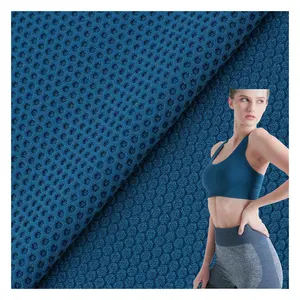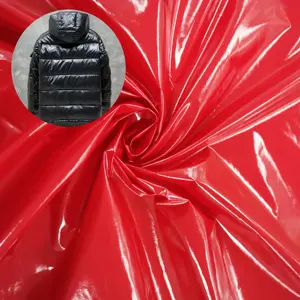
Eco-friendly Outdoor Waterproof Olefin Fabric Outdoor Sofa Sunproof Awning Beanbag Outdoor Fabric For Outdoor Furnitures


Breathable sports wear nylon 4 way stretch knitted honeycomb textured mesh yoga suit fabric for clothes
















In an era where the fusion of durability and style is paramount, the quest for the perfect material for bag production leads us to nylon fabric. This synthetic marvel has evolved from its wartime origins to become a staple in the fashion and accessories industry. The Ultimate Guide to Choosing Nylon Fabric for Durable Bag Production delves into the history, types, and benefits of nylon fabric, providing a comprehensive look at why it remains a top choice for designers and manufacturers alike. As we explore the vast offerings on Alibaba.com and the intricate balance between different types of nylon, we equip you with the knowledge to select the best nylon for your bag-making needs, ensuring a product that stands the test of time and use.

Nylon fabric is a synthetic polymer, well-suited for a wide range of products, including various types of apparel and accessories. Its inception was driven by the need for alternatives to natural fibers like silk and hemp, particularly for military applications. Post-war, its use expanded into the consumer market, most notably in women's hosiery.
The creation of nylon marked a significant shift in the textile industry, with its introduction at a major fair in the late 1930s. Despite early challenges, such as susceptibility to runs and a lack of moisture-wicking properties, the blending of nylon with other textiles improved its durability and functionality.
Nylon's versatility extends beyond consumer goods into industrial and scientific applications, including machine parts and food packaging. Its production process involves the polymerization of specific chemicals, which are derived from petroleum, leading to the creation of various types of nylon, such as the commonly known PA 6,6.
While nylon fabric has seen a decline in popularity due to environmental concerns, it remains a key material in the textile industry. Its synthetic nature means it is not biodegradable, but it is recyclable under certain conditions. The fabric's enduring attributes, such as elasticity and strength, continue to make it a valuable component in the production of durable goods like bags.
Durability is a cornerstone in bag production, as the longevity of a bag directly reflects on the brand's value. A bag that endures daily use without faltering conveys reliability and customer consideration. It's essential that a bag withstands the rigors of regular use, lasting a year or more, to ensure that it doesn't end up unused or discarded. The strength of a bag is often the primary metric by which customers judge not only the product but also the brand behind it. A durable bag, therefore, becomes a repeated advertisement for the brand, as customers use it over and over, showcasing the brand's commitment to quality and sustainability.

Alibaba.com showcases a diverse range of nylon fabrics suitable for bag production, each offering unique characteristics and benefits. Among the selection, breathable coated types stand out for their practicality in outdoor gear. Fabrics that blend nylon with other materials provide a stretchable and comfortable option for casual bags. For more rugged applications, fabrics notable for their high abrasion resistance are ideal for tactical bags and backpacks.
Sustainability is also a focus on the platform, with options like recycled nylon fabric, which combines environmental responsibility with durability. This material is suitable for casual t-shirts and can be adapted for bag designs. For those seeking elasticity and comfort, the high-density stretch nylon designed for sportswear can be repurposed for active lifestyle bags. Additionally, interlock fabrics with a blend of nylon offer a stretchable structure, perfect for creating form-fitting compartments in yoga or gym bags.
The variety extends to specialized fabrics such as the honeycomb mesh, which provides breathability and a unique aesthetic, and fabrics that offer UV protection, an excellent feature for travel bags. For designers looking to add a touch of style, knitting fabrics present an elegant pattern, suitable for high-end fashion bags. Lastly, stocklot fabrics provide an economical yet quality choice for manufacturers looking to produce bags at a larger scale.
When selecting nylon fabric for bag manufacturing, understanding the differences between Nylon 6 and Nylon 6/6 is crucial. Both materials boast high mechanical strength and impact resistance, which are essential for durable bags. Nylon 6 offers a slightly lower continuous service temperature but excels in bearing applications due to its higher load and speed tolerance, indicated by its PV rating. It's known for its stiffness, toughness, and excellent mechanical dampening, alongside great insulation qualities. However, its high rate of absorption might not make it the ideal choice for environments where moisture is a concern.
On the other hand, Nylon 6/6, while sharing many characteristics with Nylon 6, distinguishes itself with its stiffness and durability. This material is often preferred for applications where these properties are prioritized. The choice between Nylon 6 and Nylon 6/6 for bag production should be informed by the specific requirements of the application, such as the expected load, environmental conditions, and the desired balance between flexibility and strength. Both materials can be enhanced with additives to tailor their properties to more specific needs.

Nylon fabric, a synthetic polymer, is renowned for its significant strength and elasticity. These properties make it an ideal choice for bag production, where durability is paramount. The fabric's resilience to tears and runs, initially marketed as stronger than steel, has been enhanced over time through blending with other textiles. Modern nylon fabrics often consist of a mix of fibers, including polyester, spandex, or cotton, to retain the desirable attributes of nylon while mitigating its less favorable qualities.
The process of creating nylon involves the polymerization of specific compounds, resulting in a material known as PA 6,6. This substance is then extruded through a spinneret, forming fibers that are stretched to improve tensile strength and elasticity. The resulting fibers are then woven into fabrics, which may be used alone or in combination with other materials to produce a variety of textiles suitable for bag manufacturing.
Nylon's versatility extends to its ability to be dyed in a wide range of colors, catering to diverse aesthetic preferences and design requirements for bags. Its synthetic nature allows for the production of a vast array of textures and finishes, contributing to the fabric's adaptability in different styles and forms of bags. Despite its synthetic origins, advancements in recycling processes have made certain types of nylon fabric recyclable, addressing some environmental concerns associated with its production.
When selecting nylon fabric for bag production, it's crucial to consider material specifications and certifications that ensure the fabric is safe and of high quality. Certifications that guarantee that every component of the textile, including threads and other accessories, has been rigorously tested for harmful substances and is certified safe for human use are important. The testing process is thorough, covering a wide range of substances that could be detrimental to health, and often surpasses international safety standards.
Such certifications are a global benchmark for textile safety, with criteria that are regularly updated to incorporate new scientific data and legal requirements. Textiles at all stages of production, from raw threads to the finished product, can achieve certification. For nylon fabric used in bag manufacturing, this means each element, down to the zippers and linings, is scrutinized for safety. The certification process is modular, ensuring comprehensive evaluation.
Textiles are categorized into product classes based on their intended use, with varying requirements and limit values. For bags, which often involve extensive skin contact or are used in close proximity to the body, materials typically fall under the strictest standards. This certification not only reflects a commitment to consumer safety but also signals a dedication to quality. Manufacturers and consumers can verify the validity of the certification at any time, adding an extra layer of trust to the product.
Nylon fabric offers several benefits for bag production, making it a reliable choice for both manufacturers and consumers. Its inherent strength and robustness contribute to the longevity of bags, allowing them to withstand regular use and maintain their shape over time. The material's resistance to scratching and abrasion is particularly advantageous for those with an active lifestyle, and its ability to carry heavier items without compromise is a significant plus.
The water resistance of nylon is another key advantage. Bags made from this material repel moisture effectively, which is enhanced by additional coatings applied by manufacturers. This quality ensures that the contents of the bag remain dry, safeguarding against water damage. Furthermore, nylon's quick-drying properties contribute to its practicality in various environments.
Nylon's elasticity and flexibility are also beneficial, allowing for a range of design possibilities. It can be molded into unique shapes and structures, which is ideal for creating innovative and functional bag designs. Additionally, the lightweight nature of nylon makes for comfortable wear, especially in products like backpacks and messenger bags that are carried directly on the body.
Lastly, the ease of dyeing nylon means that it can be produced in a wide array of colors, catering to diverse aesthetic preferences. This versatility extends to its ability to mimic other materials, offering designers the flexibility to innovate while still leveraging the functional benefits of nylon.
Exploring Alibaba reveals a diverse range of nylon fabrics suitable for bag production, each offering unique features and benefits. Among the offerings, one can find fabrics known for their breathability and durability, making them an excellent choice for outdoor and tactical bags. The site also lists a variety of knitted fabrics, which are ideal for casual and sports bags due to their stretchability and comfort.
For those seeking environmentally sustainable options, Alibaba provides fabrics like the recycled nylon blends, which support eco-friendly initiatives while maintaining the material strength needed for daily use. Additionally, the platform features specialized fabrics renowned for their high abrasion resistance, which is crucial for heavy-duty bags and backpacks.
Manufacturers and suppliers on Alibaba also offer non-woven nylon fabrics, which are durable and reusable, and can be customized to meet specific design requirements. This customization extends to the range of fabrics available, which add a touch of elegance and unique texture to bag designs.
For businesses looking to source materials for sportswear and swimwear bags, Alibaba includes fabrics with specific performance features like UV protection and super stretch capabilities, ensuring the final products meet the functional demands of end-users. With such a comprehensive selection, Alibaba stands as a vital resource for businesses to find the right nylon fabric suppliers for high-endurance bag production.
In conclusion, nylon fabric stands out as an exemplary choice for bag production, offering a blend of durability, versatility, and aesthetic flexibility that few materials can match. From the historical significance of its creation to the modern advancements in textile technology, nylon has proven its worth in the industry. The guide has traversed through the various types of nylon available on Alibaba, highlighted the critical differences between types of nylon, and underscored the importance of certifications in ensuring product safety and quality. With its myriad of advantages, including strength, water resistance, and ease of customization, nylon fabric remains a reliable ally for manufacturers aiming to deliver products that promise longevity and style. As we navigate the extensive selection on Alibaba, it's clear that whether for high-end fashion bags or rugged outdoor gear, nylon offers a solution that can be tailored to meet the diverse needs of consumers, making it a cornerstone material in the world of durable bag production.